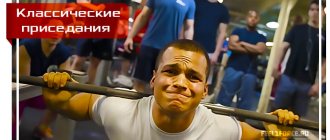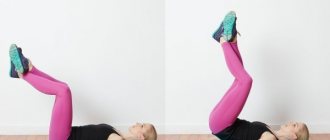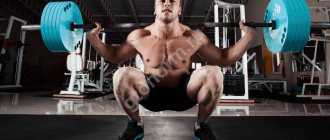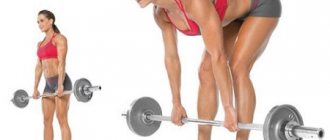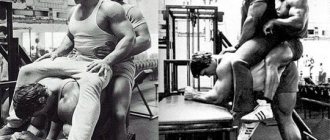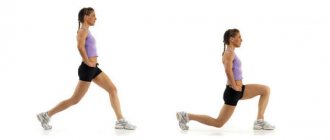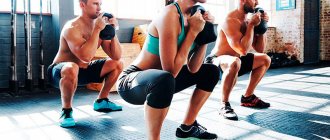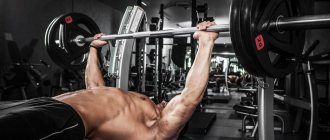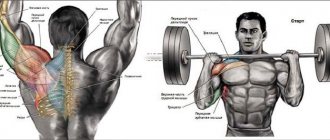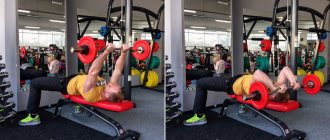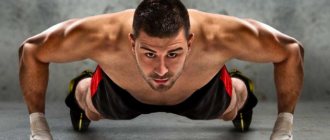Recently they have begun to say that barbell squats are not necessary. Indeed, it is easier to tell a beginner that his destiny is extension and flexion in the machine, and some kind of leg press, than to explain the technical nuances of this basic exercise, systematically work on strength and flexibility, set technique, monitor the body, the work of the knees, shins, hips, do not allow the pelvis to “peck”. In fact, the squat is available to everyone who has no contraindications to bending the knee, ankle and hip joints, and no contraindications to axial load on the spine. The movement is performed in all sports, and in fitness there is a place for a good technically correct squat, and not just half squats with a body bar.
Working muscles
The load is evenly distributed between the long back muscles, quadriceps, buttocks, hamstrings and calves. The abdominal muscles, deltoids, and latissimus muscles work as stabilizers. It is sometimes believed that the long back muscles also stabilize in the squat, but the actual situation depends on technique. If an athlete is long-legged and has a long thigh, the natural forward tilt of the back will be compensated by the work of the long back muscles.
Benefits of Exercise
For a fitness specialist, the main advantage is the opportunity to work out maximum muscles in a minimum of time. The truth is harsh - a person who does, for example, 4 working sets of squats of 8-10 repetitions with a relatively high weight, pumps up his abs and goes home or to work will be better built than his friend who hangs out in the gym for an hour and a half, but only does flexion and extension, and, at most, some platform leg presses.
For athletes and advanced amateurs, the squat is good because:
- Builds overall lean body mass . The back also grows from squatting, it’s not for nothing that experienced people will always identify someone who is lying about their working weights on the Internet precisely by the appearance of their “pillars” (long back muscles);
- Allows you to work more powerfully with your legs in all sports disciplines . MMA fighters and boxers, track and field athletes and football players squat with a barbell. Yes, they don’t lift the same weights as powerlifters, but they do this exercise to build power in the off-season. Plus, power squats are a key way to prevent injuries;
- Changes the shape of the hips and buttocks . In "old school" bodybuilding there is no leg training for a healthy person without squats. Lunges and platform presses are auxiliary exercises, squats are the main ones;
- Serves as an indicator of overall strength . Although pure strength is mostly tested, it is only useful to know it in powerlifting competitions. And exercises like the leg press are not indicators of strength, since they do not work the core muscles;
- Improves health , including blood circulation in the pelvic organs, and increases bone strength;
- Increases energy expenditure during training, helps burn fat and build muscle
Opinions differ regarding the benefits of squats for beginners and exercise enthusiasts. Objectively, squatting with minimal weights improves coordination of movements, increases joint mobility and strengthens ligaments. It does not contribute to injury if performed smoothly and under control. Opponents of beginner squats argue that such people's muscles are too weak to support the weight on their back and perform the movement technically correctly. In fact, it makes sense to give a short period of “pumping up” the muscles in the machines before squats, but it’s not worth delaying it for 4-5 months, as some trainers do, so as not to teach beginners the technique. The problem with beginners and amateurs is precisely the lack of skill and low joint mobility. The easiest way to do this is by squatting.
Features of execution:
Before we start looking at the technical aspects of performing classic barbell squats, let's look at a few important points:
Neck location:
A correct squat begins with the correct position of the barbell:
It can be placed “higher” – just below the neck, or “low” – on the lower part of the trapezius muscles.
To soften the pressure of the metal bar, there are special rubber or foam pads. They wrap around the neck. Performing the exercise will be more comfortable in this case.
Foot position:
The position of the legs should correspond to the width of the shoulders, the toes point forward, you can spread them a little. This starting position can be called classic.
Grip:
Typically a closed grip on the bar is used (position 2 in the picture). Option 1 is used less frequently because it may cause pain. Hands should be positioned symmetrically from the center of the bar. This is necessary so that you do not lose your balance while squatting.
Neck and eye position:
When doing squats with a barbell, you need to look straight at one point and not move your gaze. This will help maintain the correct position of the neck and keep it straight. You can’t lower your eyes, because you won’t notice how you lower your neck. When performing an exercise with such a posture, there is a risk of osteochondrosis or spinal injury. Remember, when squatting, you only need to look forward.
Squat depth:
You can perform the exercise until it is parallel to the floor or go lower. There is an opinion that parallel squats reduce the load on the knee joint. This effect will only occur if you squat freely - uncontrollably, and if not, then the load will be large.
When squatting deeply, the muscles of the buttocks and thighs will participate in the exercise, and with this version of squats, the effectiveness of the exercise will be much higher.
Execution technique
Beginners begin to learn the exercise from a squat to a box below the parallel of the femur with the floor. They perform the movement without a barbell, with a weight held at the chest, or with a body bar on the shoulders. As soon as a person acquires the skill of squatting with a straight back, without “unwinding” the lumbar region at the bottom of the exercise, and without bending too much forward, he can begin to be taught a classic squat with a barbell.
Before approaching even the minimum weight, you need to tune in and “scroll” the sequence of actions in your head. There is no need to run under the bar as quickly as possible and remove it at random, even if there is a line in the gym for the apparatus. Concentration in squats is the key to avoiding injury.
It's BAR SQUATS, baby!
Performing squats
- The bar is installed at the height of the athlete's collarbones, or slightly lower. You need to come up, stand under the barbell in one movement and place it on the lower part of the trapezius muscle. In fitness, it is better to avoid squats with the bar positioned on the top of the trapezius. They are quite traumatic for the cervical spine, and a novice athlete cannot always carefully remove and place the barbell from the racks, which is why he injures his neck;
- The grip should be slightly wider than shoulder-width, but stable, so that your hands do not slip towards the plates. Wider grips are allowed if shoulder mobility is lacking, but loss of balance must be avoided. The back should be tense and arched, that is, the shoulder blades are brought to the spine and lowered, but the abs are tightened and compensate for the natural lordosis. You should not throw your tailbone up; if such a movement occurs naturally, you need to tense the front surfaces of your thighs and “tilt” your pelvis forward so that the pelvic bones begin to point straight forward;
- The neck is level. The feet are on the same line under the bar, the bar is projected onto the middle of the arch of the foot, the knees are slightly bent. In one motion, the athlete extends both knees and lifts the barbell above the racks;
- Then you need to pull your stomach inward to stabilize, make sure the bar is lying flat, and take three steps - right foot back, left foot to right, and feet shoulder-width apart or slightly wider. Socks are turned to the sides, not forward. Do not squat with a barbell with parallel feet. If you need this particular version of the squat, it is better to fix your shin in a special machine and hold the weight in front of you;
- Next, the athlete makes sure that his back is slightly tilted forward, his shoulder blades are pulled together and lowered, his abs are tightened, he inhales, and begins to spread and bend his knees towards his toes. There is no need to make any movements of the pelvis. And even more so, you should not reach back, sit on an imaginary chair, etc. The energy from bending the knees and shins is enough for the hip joints to work in the plane intended for them by nature, and not the plane imagined by novice bodybuilders. On the contrary, during a squat you need to monitor the “rotation” of the pelvis and the tilt of the back. The first must be absent, and the second must be minimally acceptable. Only tall people with a long thigh squat in a “fold”, that is, initially with a tilted back, they have no other anatomical option;
- You need to squat not until the thigh is parallel to the floor, but until the pelvic bones go below the top of the kneecap. Contrary to popular belief about “the safety of the parallel squat for the knee,” the peak load in the parallel technique falls on the anterior cruciate ligaments. If you sit a little lower, the load will be evenly distributed between the hip, ankle and knee joints, and the ligaments will not be damaged;
- As soon as the touch is achieved, you need to push off powerfully with your legs and begin to straighten your knees and rise. Back movements in fitness should not be performed on small and medium weights. Similarly, you should avoid shifting your center of gravity to your toes;
- There is no need to squat quickly. You should return your back to its original position and control your abs before each repetition;
- When all the repetitions are completed, you need to go to the racks and, by bending both knees, return the barbell to them.
Efficiency Tips
- There is no need to remove and lower the barbell “in scissors,” that is, in a lunge position. With the working weight, the athlete can swing forward or to the side, and he will fall;
- A low bar squat is allowed, but not the “bar over the shoulder blades” position. This is sometimes given to girls to “load their buttocks.” Fans of loading the buttocks can do any bending with a barbell or a gluteal bridge after squats, but breaking the shoulder joints for the sake of a ghostly shift in emphasis is not worth it. Moreover, for most people, an extremely low bar means an equally significant tilt of the body forward;
- Advice from illiterate amateurs regarding moving the pelvis back and maintaining a depth below parallel is mutually exclusive. If a person takes something there, he will only reach it by “pecking with the pelvis”, or in a position where the body lies on the hips. Therefore, you need to clearly decide for yourself. If there are no injuries that prevent you from squatting, you should squat deeply, due to the movement of your knees and without moving your pelvis back. If they exist, it is worth discussing with your trainer options for replacing the squat with another multi-joint movement for the lower body;
- Bringing your knees past your toes in a squat is not dangerous, or rather, it is a necessary condition for a squat for people with long thighs. It is dangerous to squat with your kneecaps straight forward with your feet parallel. Socks should be turned out as far as the hip joint allows, all other options are not acceptable;
- But the placement of the feet wider than the anatomical width that the hip joint allows is also dangerous. This can cause injuries to the joint that takes the longest to recover, and even stretching of the adductor muscles as an unpleasant addition;
- The width of a squat “for health” is determined simply. The athlete is forced to make a high jump and land at a comfortable width. The placement of your feet upon landing will determine the possible width of your stance. It is allowed to move your legs 2-3 cm outward or inward, but do not “turn” them to the sides for the sake of a ghostly desire to pump up your buttocks. By the way, a wide squat, in addition to the buttocks, does a good job of growing the adductor muscles of the thigh, so those who like large pelvises and thin legs will not get what they want here
Warm-up is the most crucial moment. Just running and pedaling is the most useless way to warm up before a squat. Cardio is done for no more than 5 minutes, then a series of glute bridges with support on a bench is performed without weights, a series of lunges with the right and left legs, and several sets of squats without weight. Then, from an empty bar, they rise to the working weight from approach to approach, increasing the weight. The step is individual.
Leg exercises. Squats.
Squats with a barbell on your shoulders
When performing classic squats, the main load is applied to the gluteal muscles and quadriceps. The back and abdominal muscles are also involved in the work. The uniqueness of this exercise is that it is suitable for both men and women.
If you perform the exercise with a wide stance, the main load goes on the vastus thigh muscle, while with a narrow stance, the medial thigh muscle is more involved.
For beginners, it is better not to perform squats with a narrow stance, since the main part of the load falls on the back.
When performing this exercise, the thigh and gluteal muscles are maximally worked out.
Features of squats with a barbell on the shoulders:
- The width of the legs determines which part of the thigh will be worked. With a narrow setting, the emphasis is on the front, with a wide setting, on the inside.
- It is important not to lift your heels off the floor when performing squats. If you can’t do it correctly, you can place a rolled-up fitness mat or weight plates under your heels.
- The development of the gluteal muscles depends on the depth of the squat. The lower you squat, the more they are involved.
- It is important that your knees do not go beyond your toes during the exercise.
- Make sure your back is straight, without obvious arches.
- Your knees should be pointing in the same direction as your toes; there is no need to bring them together.
- If you have contraindications due to health conditions, it is recommended to replace squats with other exercises.
- Until the age of eighteen, you should not perform various types of squats, the body is still growing, and the load on the back when performing the exercise is large, this can negatively affect your health.
- The execution of the exercise depends on the anatomical characteristics of each athlete, this also needs to be taken into account. It is important to concentrate and try to feel the muscles.
Benefits of doing the exercise:
- During the exercise, the abdominal muscles are involved - this helps to create a good muscle corset.
- Proper execution of the exercise helps strengthen joints.
- The cardiovascular system is strengthened
- During exercise, a large amount of energy is spent - fats are burned.
- Increases endurance and flexibility.
Squat with a barbell on your shoulders
Squatting with a barbell on the shoulders - muscles that are involved in the work
Squatting with a barbell on the shoulders - muscles that are involved in the work
How to choose weight
Some exotic methods of selecting weights are not for squats. This is not a failure exercise, at least not until the person can control his or her body position in any state of fatigue. Repetitions are done from 3 to 12, sometimes more, this is determined by the level of the athlete and the purpose of the training.
Otherwise, follow the rules:
- The last 2 repetitions should be difficult, but for the purposes of health-improving physical education, “work” is not the hellish bending of the back forward, knees drawn inward, and lifting the pelvis upward. This is a tangible resistance of the muscles to the load, that’s all;
- You should always start with an empty bar, then move in steps from 5 to 10 kg, up to the working weight;
- It is possible to perform with different weights on different days, since recovery after training is not linear;
- Once you reach the level of “squatting your own weight” for women, and “squatting 1.5 times your weight” for men, periodization is required, that is, cycling light and heavy workouts, even if you squat once a week
Impact on the lower back and knees
Injured athletes and people with hyperlordosis should be conscious about squat training. Many people should not perform squats, at least until full recovery has been achieved.
The movement itself is not dangerous to the lower back and knees, and with weights no greater than your own can be performed without benders, bandages, or a belt.
To prevent injury, you need to pay attention to:
- Press work . The stomach should not fall forward and be relaxed. The belt push is performed only if the athlete does power squats; it should be avoided in fitness;
- Initial position of the pelvis . There is no need to stretch your buttocks upward, as we often see in photos from fitness magazines. It looks beautiful, but is very traumatic for the lower back;
- The position of the knees . They move in the plane of the foot, towards the toes, rather than inward;
- Ankle mobility . If your shin is “clogged” from walking in heels or trying to pump up your calves, you should roll it with a roller and stretch it a little before you start squatting.
Squat technique[edit | edit code]
The squat, full or partial, is a very technical exercise where safety and effectiveness are ensured, first of all, by impeccable technique. Neglecting technical precision exposes the cross-trainer to the risk of injury and lack of progress, which almost always results in failure of all or part of the training program.
- Grip width on the bar
: The hands, located slightly wider than the shoulders, hold the bar and are positioned as if pressing the accelerator of a motorcycle. The thumbs hold the bar in the lock; palms, wrists and forearms are aligned in one line. Elbows slightly back and pointing down.
- Barbell supine position
: The barbell rests on the back of the trapezius muscles, with the shoulder blades retracted to form a perfect “rest” on the back of the deltoid muscle.
- Foot position
: may vary, but is always identical on both sides. We advise you to take a comfortable and symmetrical position.
- Removing the bar from the rack
: Before removal, the bar is on the rack, slightly below the shoulder line, when the athlete is standing nearby.
- Removing the bar
: is done by lifting from a squat underneath it, while the athlete maintains a full bar. Once the bar is removed, you need to take a step back, staying close to the bar.
- Head position
: the head continues the line of the spine, the athlete fixes the direction of his gaze straight ahead.
- Leg Curl
: Squeeze your knees and hips at the same time to slightly lower your center of gravity. Keep your stomach flat without arching your lower back too much. Lower the hip joint to a certain level, depending on the type of squat you choose - full or partial. The knees are in the same plane as the hips and feet. The heels rest on the floor.
- Leg straightening
: Extension of the knees, hips and torso should occur synchronously, avoiding knees. Standing up should be symmetrical and without stopping.
- Critical moment
: When the femur and tibia form a right angle, muscle tension reaches its maximum. At this moment the line of movement should be perfect.
- Speed of execution
: There are many techniques. In general, the descent should be controlled, and the search for speed of execution occurs mainly during the ascent.
- Breathing
: inhale at the beginning of the bend, then exhale sharply at the end of the straightening. Throughout the entire exercise, the trainer will pay double attention to the position of the back and control the anterior tilt of the pelvis, which guarantees the preservation of natural curves (rounding the back is unacceptable and should lead to a change in those responsible for the “purity of execution”).
Final Cautions
And yet, despite all these potentially productive and injury-preventive technical results, the squat's historical detractors are not necessarily completely wrong. Under the guise of being concerned with efficiency, some cross-training trainers can sometimes forget the absolute caution they must exercise at all times, the age of the trainee being a primary consideration. The young public should be trained to achieve results, not to demonstrate them. Work on squats for young people, of course, has not been cancelled. This is work on technique. More and more cross-trainers are starting with cross-training without any technical background, so there is no need to rush into teaching.
Finally, training in heavy squats, both deep and partial, should not begin until sufficient plank levels and lower (and upper) limb strength have been achieved. Thus, the wisest thing to do during the initial period would be to build a strong foundation for a healthy and effective practice. squats for many years
.
The student will have to go through a “technical filter” in parallel with the analytical and methodical strengthening of his body.
Smith machine squats
This should be the shortest section. The upright Smith machine is not designed for squats. You can still do bench presses, lunges and vertical presses in it, but not squats. Why? It's simple. During the squat, the barbell moves in a straight line only for super flexible professional level athletes. For most fitness specialists, it “travels” along an elliptical path, and this is normal. If you “forcibly” try to straighten the trajectory, the load on the hip joint increases. If you place your feet slightly incorrectly, you can get injured.
The Smith squat “square”, that is, in the “feet in front” position, is one of the most anatomically unnatural movements that overloads the spine. It is contraindicated for scoliosis, hernias, protrusions and even simple pain in the lumbar region due to hypertonicity. It is performed in bodybuilding to shift the load to the buttocks, but it is done either by healthy people or by those whose priority is pumping up the buttocks rather than maintaining health.
There are benefits of training at Smith, perhaps, for high-level bodybuilding:
- During training, an athlete can use work “almost to failure”, since he has the opportunity to place the barbell on the supports at any point of the amplitude;
- In one approach, you can change the placement of your feet;
- A variety of positions of the bar on the back are allowed, including very high
If a person cannot barbell squat according to his level of fitness, he should do a goblet squat or a cable squat, but not a Smith machine movement.
How to squat with a barbell correctly: everything you need to know
Equipment
Equipment has a positive effect on the exercise, especially if you are working with heavy weights. Here are a few things that will be helpful for performing squats.
Shoes
The purpose of tennis shoes is to distribute body weight evenly and provide shock absorption. But when you do squats, you plant your feet on the floor, so if you wear thick, soft-soled shoes, you'll lose some energy by sagging in those shoes. This will also make your body position unstable. Those who perform squats in sneakers may find their knees sinking and feeling unsteady.
At a minimum, you should use hard-soled shoes. Converse is a great choice. I also like weightlifting shoes (weightlifting shoes). Their most important advantage is that they have a hard sole and high heels.
A high heel creates a comfortable body position for performing squats, allowing you to make the greatest effort.
Athletic belt
A reliable lifting belt will greatly benefit you when performing squats. It will give support to tense core muscles, protect the lower back, and help keep the body upright.
Rumors that using a belt will weaken your core muscles over time are nothing more than rumors. Research shows that the athletic belt activates your core muscles because it provides resistance to tight muscles.
Most people wear their belt too low. The belt should not cover the waist, but the abdominal wall in the place where it protrudes forward during the exercise. Find such a place and wear the belt exclusively on this area.
I recommend purchasing a sturdy belt with a buckle. Its thickness should be at least 10-13 mm and its length 10 cm.
Knee wraps or knee pads
Bandages and knee pads will help keep your knee joints warm and provide additional support. I prefer knee braces to wraps because they are easier to put on and take off, and there is evidence that wraps can put too much pressure on the kneecaps.
Plus, I like knowing that I'm lifting weights without the aid of knee wraps.
Chalk (magnesia)
Most of you are used to applying chalk only to your hands. Chalk absorbs moisture and thereby improves your grip. Since the bar is on the shoulders when doing squats, there is no need to apply chalk to your hands.
However, when performing low bar squats, chalk will help keep the bar on your back and prevent it from slipping.
Therefore, I recommend applying chalk to your back before you begin squats, especially if you are going to be lifting heavy weights.
Wrist bandages
For those who perform squats with a high bar position on the shoulders, wrist wraps may not be necessary. But they will be useful for low bar squats. Bandages help keep your wrist straight and prevent pain in your wrists and elbows.
One mistake people often make is that they wrap the brush too low. To provide proper support, the wrap should cover the wrist just above and below, as well as the bottom of the palm.
Squats for girls
Many people are afraid of “swinging their hips,” but since this issue is not decided by training, but by nutrition, fears can be left outside the gym. Girls who eat “to lose weight” will not build up an impressive mass.
Here is an example of a squat workout “for weight loss”, all exercises are performed for 12-15 repetitions, with strictly 45 seconds of rest between sets:
- Bar squat;
- Romanian deadlift with dumbbells;
- Hamstring curl;
- Gluteal bridge;
- Hip extension in glute crossover
Squats. Execution technique for girls
Example workout
Start your workout with a warm-up. Jump rope for 5 minutes or run on a treadmill. Do 2 sets of 20-25 squats and 2 sets of 20 lunges without additional load.
At home
Below is an example of a barbell workout. If you don't have one, do the exercises with dumbbells, as they are similar to a barbell.
- Squats – 3 sets of 12 reps.
- Wide sumo squats – 2 to 12.
- Lunges – 3 x 14 repetitions.
- Calf raises – 3 to 14.
In the gym
- Barbell squats – 3 to 12.
- Sumo style deadlift – 3 x 12.
- Lunges – 3 x 14 repetitions.
- Leg press in the simulator – 3 to 12.
Finish your workout by stretching. To relieve tension on the front of your thigh, bend one leg at the knee and touch your heel to your buttock. Stay like this for 30 seconds and then repeat the same for the other leg. To relieve tension in the back of your thighs and calves, sit on the floor, straighten your legs and, leaning forward, reach your feet with your hands.
Types of squats
These variations are performed to work the muscles more deeply, or to work on the weak points of the power movement in powerlifting.
"Sumo"
Simulates a stance in a sumo deadlift. Develops hips, buttocks and hip adductors.
Frontal
The barbell is held on the chest, a clear approach is required. The body cannot tilt forward.
Zerchera
The barbell is held by bending the elbow, at waist level. The movement serves to correct excessive forward lean in the classic barbell squat.
Hackenschmidt
The barbell is grasped with a straight grip behind the back. Some believe that this works the hamstrings and buttocks better.
Lunge Squat
One of the scissoring movements that corrects leg imbalances is essentially one foot placed slightly back on the toes and the athlete simply lowers into a squat from that position.
One leg squat
The athlete stands on the box, stretches forward or simply lowers the non-supporting leg and performs the movement first with one leg, then with the other. This is necessary to correct the “difference in strength” of the legs.
